This article takes a deep dive into the European linkbuilding and basically serves as a handbook for linkbuilding today: how to build the link profile, how to choose backlinks, how much to pay for a link, pros and cons for different sources, where to get sponsored content from and how to know your hard efforts are working? This article is part of the international report SEO & Content Marketing 2023 by WhitePress and is used with explicit permission. Download the full report for with expert comments NL here.
Most beginners associate SEO primarily with positioning activities carried out within a website. People taking their first steps in online marketing, bloggers, or novice e-commerce owners often aren’t aware that there’s something called Off-site and Link building activities. While these are the elements that primarily build the position and credibility of a website! However, they must be skillfully combined with On-site activities, which is why the vast majority of SEO specialists understand the need to combine On-site and Off-site SEO:
- Who writes sponsored articles? In the majority of cases, it is the SEO specialists themselves, sometimes with the support of a copywriter.
- What should anchors look like? Above all, diversity is key.
- Where do most links come from? It turns out that it is possible to get up to 40 or more links per site from your own backlinks and 301 redirects.
- Prices: sponsored articles are the most expensive.
- How to measure the effects?: it is worth combining several metrics, e.g., traffic, position for phrases, and visibility.
Among SEO specialists, by far the fewest are those who professionally deal with Off-site activities exclusively.
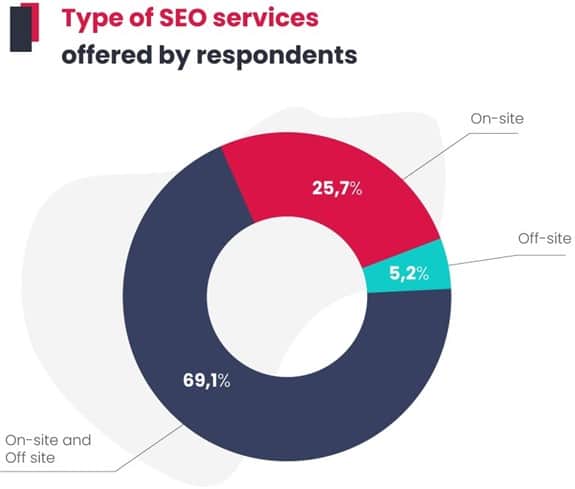
This represents only 5% of all the respondents. The vast majority of people, 69%, combine both On- and Off-site SEO strategies. This type of approach is strongly supported by experts.
26% of the respondents focus solely on On-site SEO activities. On-site SEO has long had a reputation for being simple to implement, making it more popular with those who are just taking their first steps in the field of site optimization. It also carried a lower risk of penalties than Link building, which already requires knowledge beyond the basics of SEO. Nowadays, professionals realize that it is necessary to combine these two aspects, as confirmed by the results of the study.
In the study, we focused on two aspects of SEO: On-site and Link building. However, naturally, this is a simplification of a very complex topic. Components such as Off-site activities, besides Link building, remain concentrated on brand building.
Despite the vast number of elements that make up SEO as a whole, in this publication, we have decided to primarily focus on the aspect of Link building, which remains one of the most crucial aspects of an SEO professional’s daily work.
Link building without secrets
The techniques used by marketers to acquire links are various: from posts on forums, through guest blog posts, up to buying sponsored articles. It all adds up to Link building, the essence of Off-site Search Engine Optimization.
How much does Link building cost?
Summing up the answers of our respondents, it can be stated that up to ¾ of them spend no more than half of their customer budget on it.
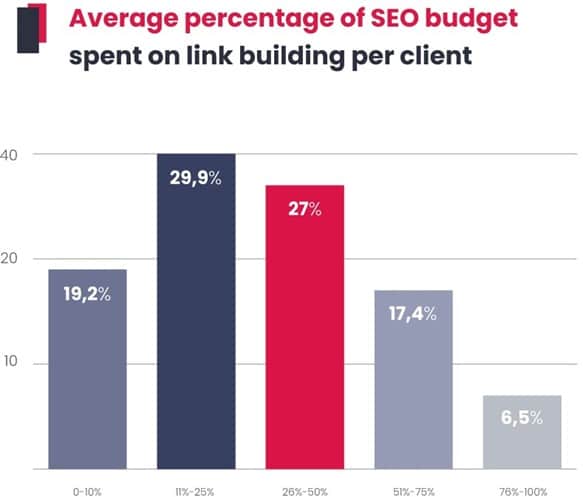
It is hardly surprising, since data collected from people working for leading Link building agencies shows that one good-quality sponsored article can cost from several hundred dollars upwards. The cost of the publication itself must also be added. The better the statistics and reputation of the service, the more expensive it will be. In the case of national news outlets or major trade portals, these amounts can reach tens of thousands of euros.
And yet, this does not constitute an obstacle for marketers, because as many as 76% of them very often, frequently, or sometimes turn precisely to sponsored articles when they need high-quality external links. The remaining techniques proved to be much less popular.
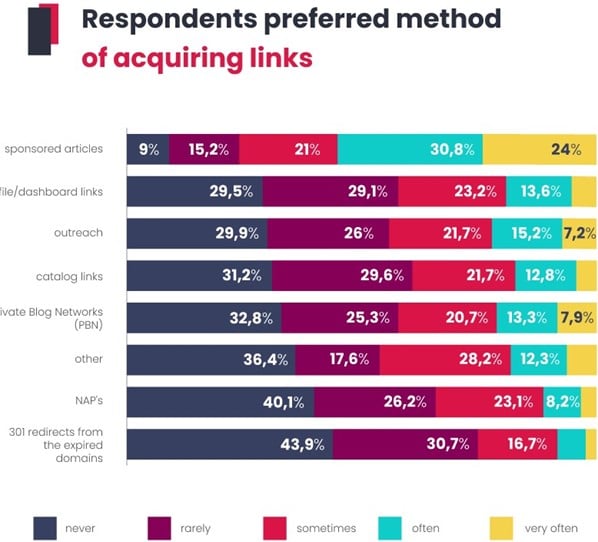
Where do SEO specialists get their links from?
At the beginning, it is worth noting that SEO specialists mostly aim to diversify their link sources. They are rarely (31% of respondents) or very rarely (31% of respondents) sourced from the same site several times. According to the experts, acquiring multiple links from the same website can be beneficial in certain contexts. This strategy can be particularly useful when operating within a narrow scope of interests.
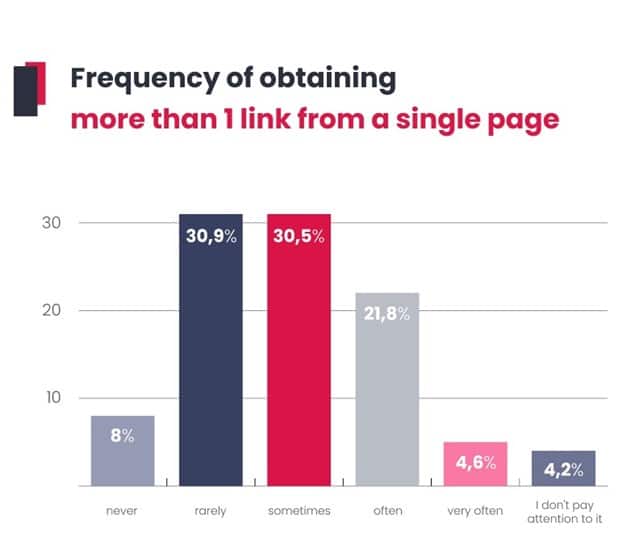
In summary, although diversification is usually preferred, there are situations in which acquiring multiple links from a trusted and high-quality source can enhance credibility and contribute to a natural link profile.
Link profile
Marketers agree when it comes to sourcing links from sites that are in a different language than the target site. 38% of them never do it, and the following 55% do it rarely or very rarely. It is a good practice to ensure not only that the language “matches” the target domain, but also that the subject matter coincides
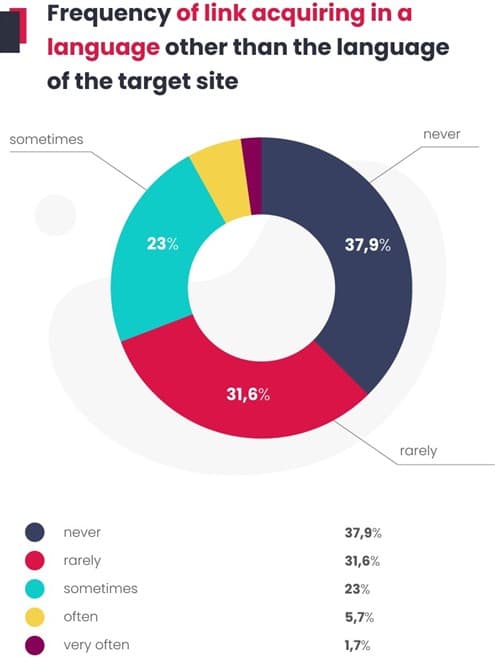
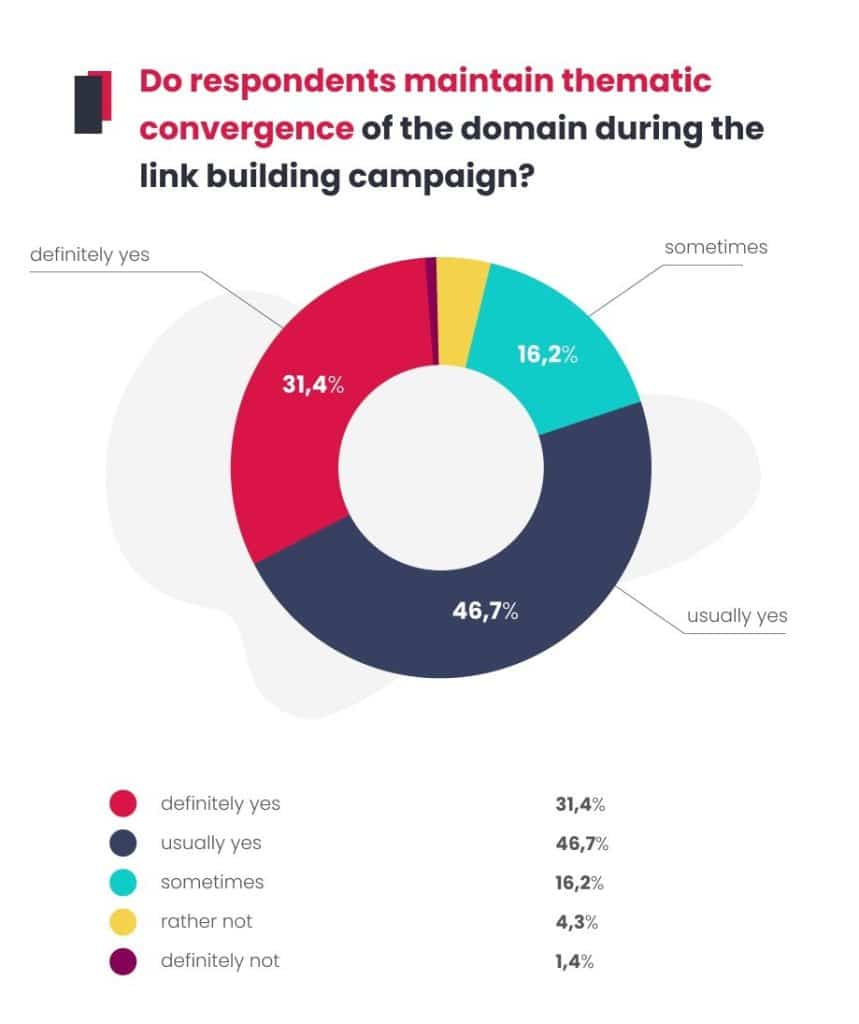
78% of those involved in link acquisition place a high value on this, while 16% focus on it only sometimes. The French are the most particular about this, with more than half definitely looking at the site’s subject before deciding to link there. Only one in twenty SEO specialists doesn’t bother with this at all.
Link quality
Acquiring links from high-quality domains helps search engine robots determine the context of the linked page, enabling them to later assess the extent to which it will match the keyword phrase searched by users and whether it will appear prominently in search results for that query. The topic of domain quality is related to the possibility of lowering the position of a site linked to by “suspicious” sites. Low estimated organic traffic or low- quality content constitute factors by which such a poor domain can be recognized. Can links from such sites cause harm? Here is what respondents say about this:
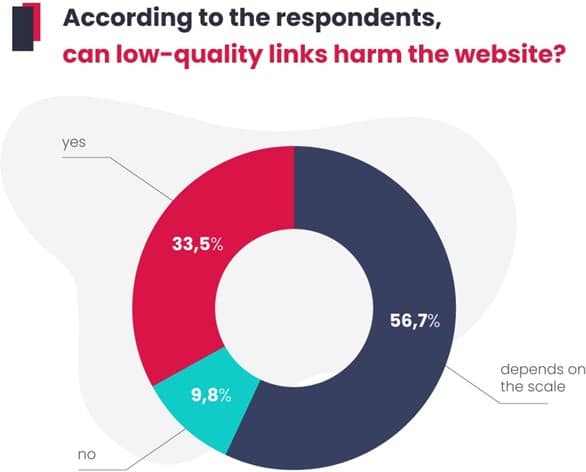
Considering the experts’ opinions, it’s safe to assume that behind the term “it depends,” which was supported by nearly 60% of individuals, there are more negative connotations than positive ones. SEO professionals approach this type of linking with a healthy skepticism and caution—not without reason, as such practices can lead to negative consequences that both the website and the company can feel.
Public Relations and SEO
Link building and its impact on SEO is a relatively well-known and researched topic. However, the branding and PR perspective is often overlooked. Expert comments might suggest that in the near future, we could witness a closer integration of what was once isolated SEO with broader marketing efforts, following the principle of creating for people, not just for Google’s algorithms.
How do SEO professionals choose link placement: key parameters
Finding suitable sources for Link building can be a challenging task. We asked respondents what they primarily focus on during this process. As many as 96% of all respondents claim that the factual content of a domain, from which they acquire their links, is important to them. The visibility of the website on Google and its subject are also very important. More technical issues (such as Domain Rating, and Domain Authority) were further down the list.
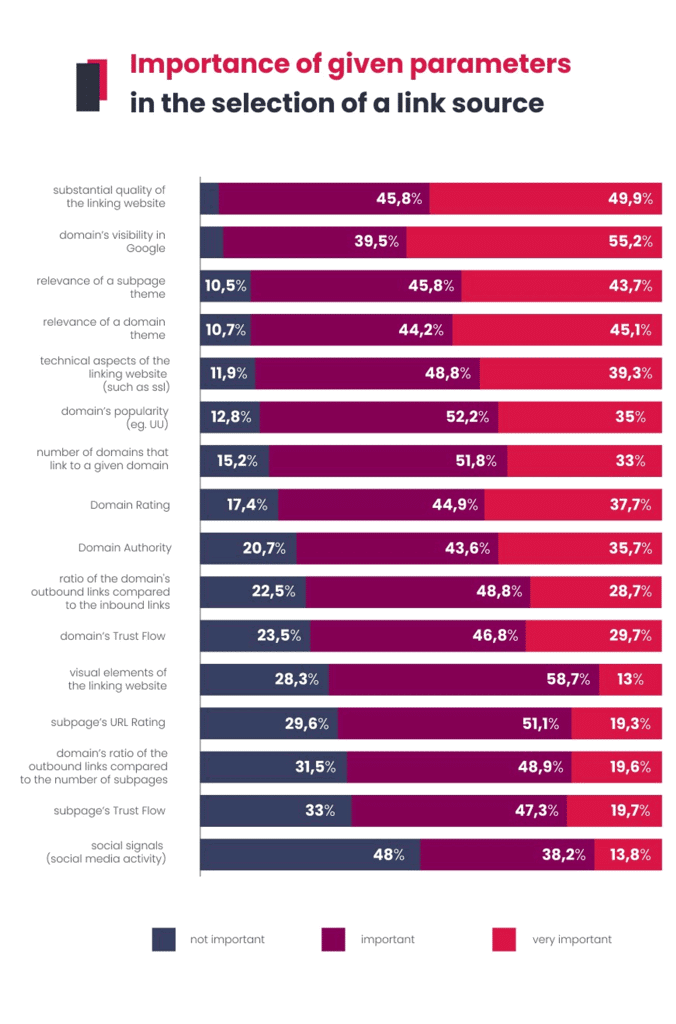
However, there is no single correct set of parameters that an SEO professional should focus on.
The Impact of Social Media on SEO
The study confirmed our hunches: social media activities are not a priority for SEO professionals. Among all factors, social media activity turned out to be the least significant. Half of the respondents in this context do not pay attention to it at all, mainly because its direct impact on SEO has never been confirmed by Google. However, it’s worth noting that even if mentions on social media don’t have a direct impact on Google rankings, they can influence SEO in various other ways.
But will impact of SM on SEO will increase in the future? WhitePress asked its respondents about this – the results may come as a surprise. Almost 30% of them believe that yes.
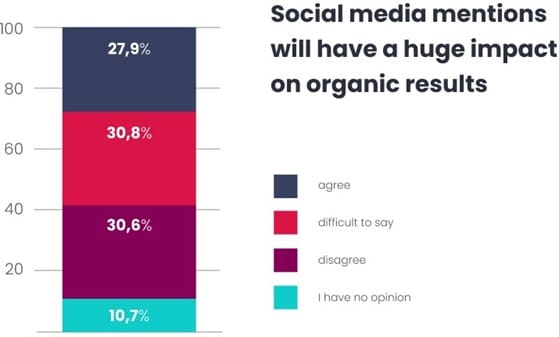
This doesn’t only apply to organic results in Google searches. When considering the direct impact of social media on search result rankings, it becomes evident, especially with platforms that are owned by Microsoft, such as Bing or LinkedIn.
Anchor texts in Link building. How to do it?
Another question from our survey showed that Off-site SEO is considered a more sophisticated area. We’ve asked about the form of anchor texts. Should they perfectly match the content that can be found on the landing page? Or is a certain amount of imagination advisable, with various anchors improving the visibility of the domain? The fact that opinions on this subject are so divided shows the complexity of the topic.
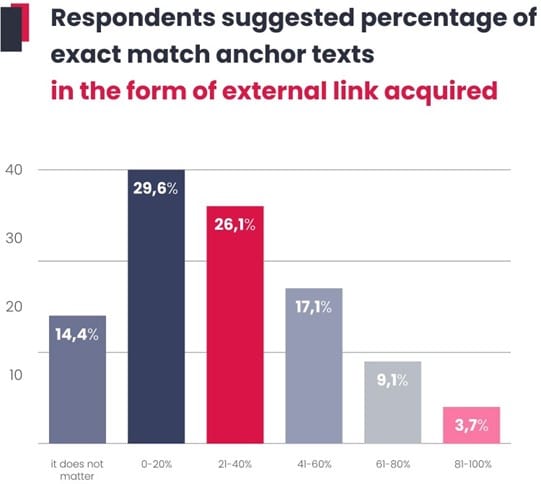
Only 14% of respondents state that this does not matter at all. In the case of the rest, it is possible to paraphrase the old saying “one SEO specialist’s meat is another’s poison”. However, the prevailing opinion is that at most 20-40% of anchors should perfectly correspond with the content of a domain (so if a website includes a “Report on SEO — WhitePress®”, then the anchor should be: Report on SEO — WhitePress®).
This is in line with the opinion of major market experts. According to Base Research Marketing (2022), between 5 and 10% of anchors are expected to be literal. SEO Chatter reports (2022) that this should be at 5% at most. This is also what SEO Jet advises in a 2023 guide. Search engine algorithms are sensitive to artificially sourced links. Exact match phrases can potentially lead them to focus their attention on a particular page, condemning it to, paradoxically, a worse rather than a better place among search results. According to the opinion of surveyed SEO specialists, more diverse phrases will be better.
Number of links from various sources: analysis
During the study, we asked about the number of links that SEO specialists acquire from various sources. We’ve divided the possible responses into values from 1 to more than 40, where “more than 40” was the highest possible indication. It turns out that the largest percentage of respondents indicated acquiring more than 40 links for the domain from their own backlink pages and 301 redirects.
Which links are the most difficult to acquire? It seems that those of the outreach type, because as many as 68% of people obtain only 1 to a maximum of 5 links per domain through this way, which also indicates that SEO specialists with great experience and extensive contacts among numerous domain owners are the best in this. This requires a lot of commitment from them and is time-consuming, often for free, not counting the time an SEO specialist spends on work.
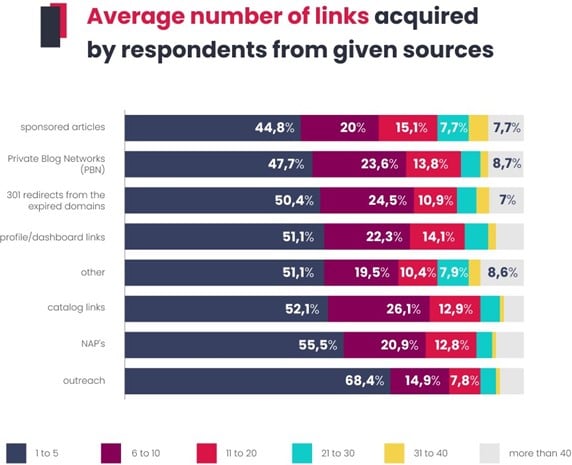
How much per link?
What is of particular interest to novice SEO specialists are the standard prices for acquiring links. Professionals with years of experience have their own rates or ways and rarely share this information. Insights into market practices are provided by sites such as WhitePress®, where it is possible to see what rate would be acceptable for blog or domain owners. However,
until now, there have been no major international studies on the subject. At most, US data was publicly available, such as that collected in 2019 and 2022 by the Growista service from several leading SEO agencies. It turned out that when acquiring links through outreach, it is necessary to spend an average of USD 200, and for a link in a sponsored article, USD 250. And what is it like in Europe?
Our data confirms that sponsored articles are the most expensive. In the UK or Germany, prices of EUR 300 or even EUR 567 can be found quite often. On the opposite side of the spectrum are countries like Romania, where 70% of people spend less than EUR 41 on sponsored articles, and some even spend less than EUR 10.
What are the pros and cons of individual link sources?
“There has always been a key to success in Link building: diversification. This remains true today. Anyone aiming for good results should use all (high-quality, not all possible!) methods for acquiring links. Below are the most popular link acquisition methods with brief comments, and for the methods still in use, their pros and cons are indicated – mostly for Poland where WhitePress originates.
1. Sponsored Articles:
Currently, the most popular link acquisition method in Poland. This method has been in use for about 10 years (since 2013, with the first ‘Penguin’ update marking the start of its popularity). Notably, sponsored articles have lifted SEO out of the basement. Since SEO professionals acquire their links in this way, they’re not ashamed to show them to their clients.
Pros:
- Accessibility: log into WhitePress® and handle the whole process in 10 minutes. 🙂
- Safety: I don’t know of any cases where links from high-quality sites have caused problems with the Google algorithm.
- Benefits beyond SEO: articles on high-quality sites provide not just links, but also the opportunity to gain additional traffic and support other marketing channels.
Cons:
- Cost: this might be a hindrance for clients with smaller budgets.
- Method prevalence: due to this method’s popularity, some sites are overused, having too many outbound links compared to inbound ones, causing their strength to diminish over time.
2. Outreach
This method is essentially unused in Poland, but it’s highly popular abroad. I believe it can be very effective in certain industries (such as B2B software) and utterly pointless in others.
Pros:
- Uniqueness: through this method, you can acquire links that our competition doesn’t have. Uniqueness in SEO holds significant value. You can acquire links that are essentially impossible to buy.
Cons:
- Cost: usually, You pay more for such links than for sponsored articles.
- Time: linked to cost. Acquiring links this way demands a lot of time.
- Small scale: this method can’t build numerous links in a short time (at least I’m not aware of such cases). If you’re working in a competitive industry, this could be a significant obstacle.
3. Forum Links:
This method was once very popular due to automation tools like xRumer (before 2013). Forums allowed the acquisition of even tens of thousands of links in a single day. Unfortunately, they were overused, and new ones aren’t appearing. Better skip this method,
4. Directory Links:
In Poland, there were thousands of directories in the past. One could say that directories in 2010–2012 were what sponsored articles are now—the most common method of acquiring links. Today, there are virtually no valuable directories (in Poland, the list would fit within 50). If you care about local SEO, it’s worth adding your website to the most well-known directories.
For the Netherlands, please read this article on directory links in the Netherlands.
5. PBNs (Private Blog Networks):
Since 2022, PBNs have been experiencing a renaissance. Once a highly popular method, they’ve made a comeback in a slightly different form. Nowadays, PBNs are based on expired domains and often replicate what was on those domains before.
Pros:
- Uniqueness: this method allows you to acquire links that our competition can’t.
- Full control: if PBNs are owned by you, you decide where to place the link and when to add and remove it.
Cons:
- Issue with availability of expired domains: since the method regained popularity among SEO specialists, expired domains are difficult to access and their prices are high.
- Significant effort: creating PBNs involves a rather labor-intensive process: buying domains, setting up servers, creating websites, and managing them.
- Relatively high risk: a lack of appropriate quality could render these links insignificant in the next Google update. We experienced this in December 2022, when many PBNs lost their ‘power.’
6. 301 Redirects from Expired Domains:
This method hasn’t been effective for a fairly long time. Redirecting a domain immediately after its purchase won’t yield results. The only way is to recreate it and redirect it after some time (which doesn’t always yield results). Since the process is similar to creating PBNs, the same pros and cons apply.”
Where to get sponsored articles from?
And where do SEO specialists get the sponsored articles they order?
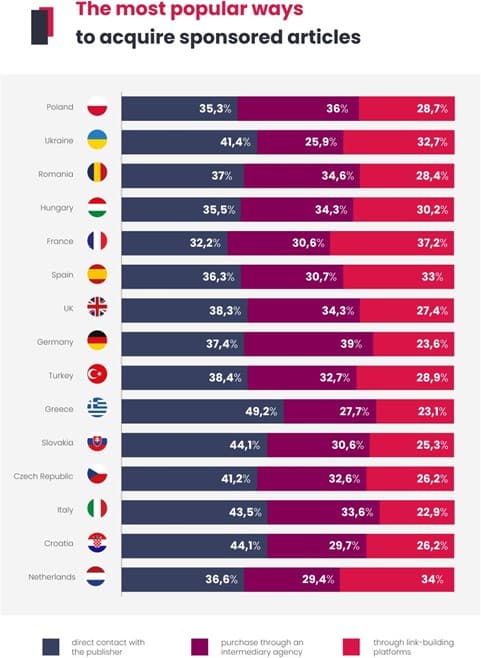
We gave our respondents a choice between three options: direct contact with a publisher (e.g., a blog owner), purchasing an article through an intermediary agency, or ordering through Link building platforms. These three options were more or less equally popular, with the slight advantage of ordering the article directly from the publisher.
Off-site SEO: how do you know if it’s working?
Finally, we asked our respondents how they would know if their Link building strategy was working. It confirms the well-known SEO principle that it is worth measuring several factors simultaneously. Only juxtaposing them with each other makes it possible to determine whether the objectives have been achieved. This is precisely what our respondents do: they report the effects of SEO just as often by means of website traffic, page placement for selected phrases, and search engine visibility.
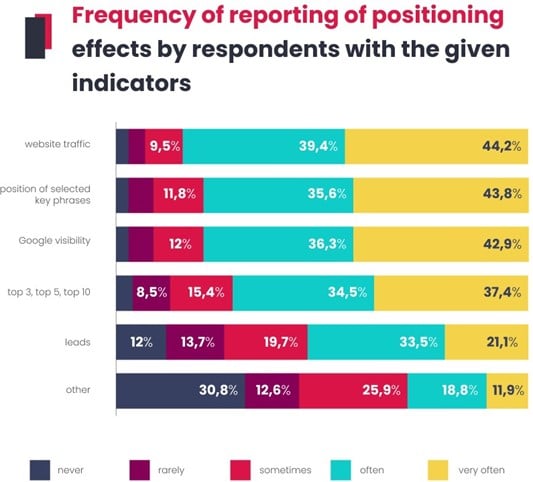
It seems that this trio is indeed capable of providing a fairly comprehensive picture of the effectiveness of SEO activities. Only slightly over half of the respondents often or very often use leads as a metric. This might be related to the specifics of some websites (long path from site visit to purchase, lack of specific sales goals, etc.).
There is no one-size-fits-all
Link building is a complex field within SEO and presents one of the most demanding challenges because it’s costly, and its outcomes can’t always be predicted. This topic is incredibly intricate, and the effectiveness of Link building efforts depends on numerous factors. Industry, website age, market competition, content quality, and evolving search engine algorithms all play a role.
Industry experts presented diverse approaches to various aspects of this process, and the quantitative study itself offers a wide field for interpretation. There isn’t a one-size-fits-all approach that guarantees success. Therefore, continuous testing of different techniques and adapting strategies to changing conditions is crucial, along with patience, as it’s only over time that we’ll see the effects of our efforts.
This article is part of the international report SEO & Content Marketing 2023 by WhitePress and is used with explicit permission. Download the full report for NL with expert comments here.




